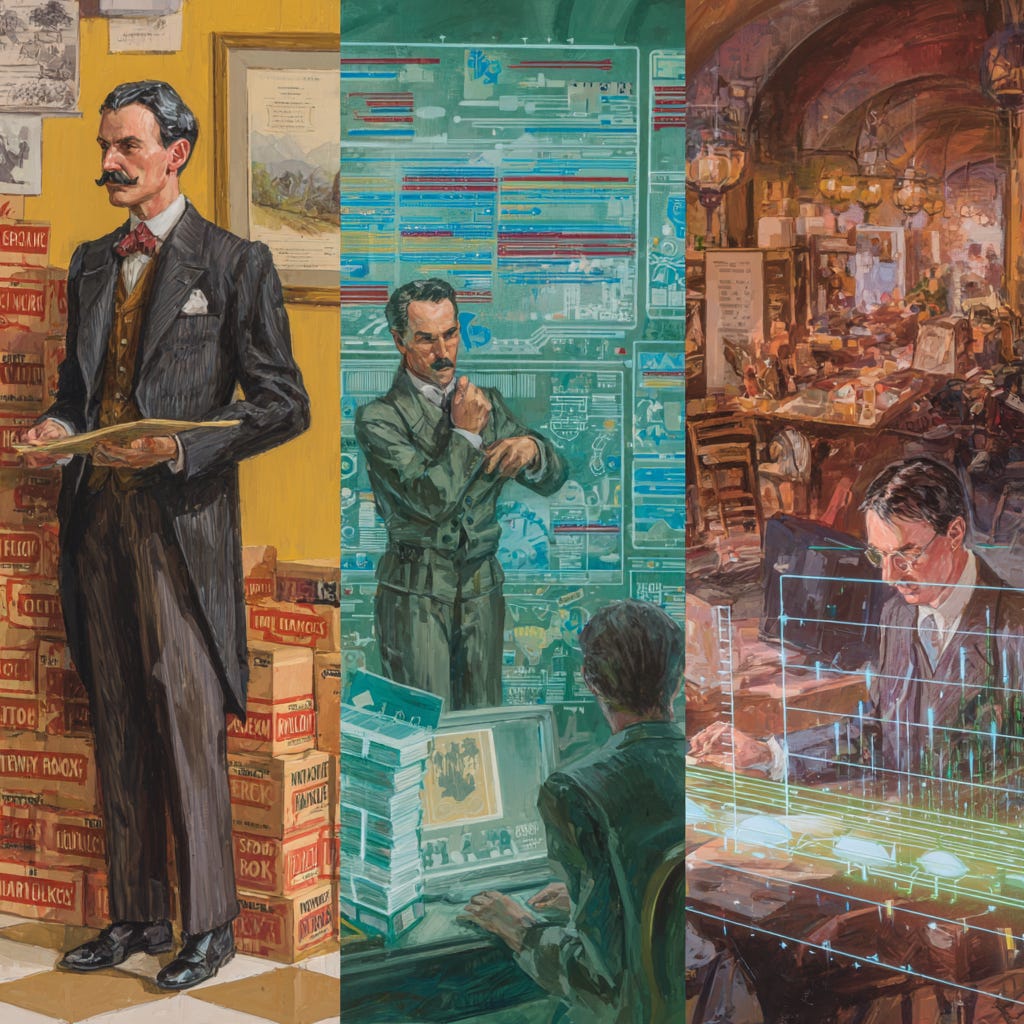Your Product Manager Job Is About to Be Eaten by AI
And it's the best thing that could happen to your career. A survival guide for the new age of product management.
Let’s be honest. For years, the B2B Product Manager’s toolkit has been a trusty Swiss Army knife: a bit of data analysis, a splash of user research, a sprinkle of stakeholder wrangling, and a whole lot of writing documents. It’s a great tool. It gets the job done.
Now, imagine someone just handed you a lightsaber.
That’s Artificial Intelligence. It’s not just another gadget for your knife. It’s a force that’s fundamentally rewiring what it means to build B2B products. The big question isn’t if your job will change, but how you’ll change with it. Are you about to be automated into oblivion, or are you on the verge of becoming a “Superworker” PM, capable of shipping products at a speed that would make your past self dizzy?
Spoiler alert: It’s the latter. But only if you play your cards right.
A Quick Sip of History (Don’t Worry, There’s No Pop Quiz)
The PM role has had more makeovers than a reality TV star. Each time, a new technology wave hit, and we had to adapt or get washed away.
The Agile Makeover: Remember the dark ages of writing massive, 100-page requirement documents and yeeting them over the wall to engineering? The Agile Manifesto shattered that, dragging us out of our caves and forcing us to talk to people, prioritize backlogs, and use sticky notes like our lives depended on it. We went from being lonely authors to collaborative team leads.
The Mobile Makeover: Then came the iPhone. Suddenly, we had to think about tiny screens, distracted users, and a million different operating systems. We became obsessed with a whole new dictionary of acronyms—LTV, KPI, SDK—and learned that if an app wasn’t dead simple, it was just dead.6 We went from web masters to data-driven wizards.
Each shift felt huge, but they were just the warm-up act. The AI glow-up is the main event.
Your Job, Now with 100% More Robot Brain
So, how is this lightsaber actually changing the day-to-day grind? It’s taking the most robotic parts of our job and doing them better, faster, and while we sleep.
1. Discovery on Autopilot: The Intern Who Never Sleeps
Remember the soul-crushing task of manually sifting through thousands of support tickets, survey responses, and sales call transcripts, trying to find that one golden nugget of customer insight? It was like trying to find a specific piece of hay in a giant haystack.
Now, you have an AI intern who’s a speed-reading, pattern-spotting genius. Tools can ingest hours of customer calls and spit out a themed summary of the top pain points and feature requests before you’ve finished your morning coffee. This is exactly what platforms like Pulse (www.pulsegen.io) are delivering for product teams today.
AI can monitor your competitors’ websites and send you a neat summary in Slack the second they change their pricing page. This isn’t just saving time; it’s turning market research from a once-a-quarter chore into an always-on intelligence engine.
2. From Napkin Sketch to Working App in Minutes
The old way of prototyping was a painful relay race. You’d write a spec, hand it to a designer, wait for a mockup, then hand that to an engineer, and wait again for a clunky prototype. The whole process felt like sending a message by carrier pigeon.
Generative AI is the teleportation device you’ve been waiting for.
Got a sketch on a whiteboard? Turn the sketch into a detailed product specification easily with AI.
Have an idea for a new landing page? Framer AI can generate a fully responsive site from a single text prompt.
Feeling ambitious? With cloud environments like Replit, v0 and many others you can describe a simple B2B tool say, a CRM dashboard and get functional, deployable code back.
You can now test three different onboarding flows in a single afternoon, before a single Jira ticket is written. The feedback loop just collapsed from weeks to hours.
Why Is This Happening Now? The Triple Espresso Shot of Change
This isn’t just happening because the tech is cool. Three massive forces are shoving every B2B company into the AI pool, whether they can swim or not.
The C-Suite Mandate: Your CEO and CFO just read an article about operational efficiency. They’ve issued a new directive: “Stop hiring so many people and get going with AI.” It’s the new corporate mantra. AI is no longer a fun experiment; it’s a core part of the business strategy to cut costs and boost productivity.
The Competitive Arms Race: Your competitors are already using AI to find new customers, personalize their sales outreach, and build smarter products. Not adopting AI is like showing up to a Formula 1 race on a unicycle. You’re not just going to lose; you’re going to get lapped.
The Data Gold Rush: For years, companies have been sitting on mountains of data CRM logs, support tickets, web analytics without a good way to make sense of it all. AI is the ultimate mining equipment. It can sift through that data to find “white space” markets, identify the perfect micro-segment of customers, and even predict which existing clients are ripe for an upsell. One logistics company used AI to find an estimated $100 million in new cross-selling opportunities its sales reps would have never found on their own.
The Survival Guide: Your PM Cheat Sheet for the AI Era
Feeling a little overwhelmed? Don’t be. Here’s how you can stay ahead of the curve and start using your new lightsaber.
Quick Hacks for the Seasoned PM:
Go from Idea to “Thingy” in 30 Minutes. Pick one AI prototyping tool like v0 or Replit and master it. The next time you have an idea, build a rough version yourself and show it to a customer. The power to validate your own ideas in an afternoon is a career superpower.
Build Your Own Skynet (For Spying). Stop checking competitor websites manually. Set up a tools to monitor their product and pricing pages. Get AI-powered alerts in Slack the moment they make a move. You’ll look like a genius who’s always one step ahead.
Become an Editor, Not an Author. For your next PRD, don’t stare at a blank page. Ask ChatGPT to write the first draft based on a detailed prompt. Your job is to then edit, refine, and inject the critical business context and human empathy. This simple shift can boost your productivity by up to 40%. Build a loop of feedback → analysis → prioritization → action. Take Pulse, for instance - an AI-native feedback intelligence platform that unifies support tickets, call transcripts, app reviews, and more into prioritized insights for PMs. What once took nights of poring over spreadsheets is now streamlined into feedback-to-roadmap cycles with minimal manual effort
Learn to Speak Robot (aka “Prompt Craft”). The quality of your AI output depends entirely on the quality of your input. Start a personal library of killer prompts for common PM tasks: generating user stories, brainstorming feature names, or summarizing technical docs for your sales team.
How to Break In (For Aspiring PMs):
Build a Portfolio of One. A resume is nice, but a demo is undeniable. Pick a B2B SaaS product you love. Dream up a new AI-powered feature for it. Write a one-page PRD, then use a free tool like Framer AI to build a simple, interactive prototype. Document your process. This single project is more valuable than any bullet point on your resume.
Get the Gist of AI (No Ph.D. Required). You don’t need to know how to code a neural network. But you must understand the difference between a system that is deterministic (like a calculator; 2+2 always equals 4) and one that is probabilistic (like an AI; it gives you the most likely answer, but it can be wrong or “hallucinate”). Understanding this is key to managing AI products.
Be the “AI Person” at Your Current Job. You don’t have to wait for a PM title to get experience. Find a small, annoying process at your current company and figure out how to improve it with an off-the-shelf AI tool. Write a one-page proposal and show it to your boss. This initiative is exactly what hiring managers are looking for.
The Punchline: Your Job Is Safe (If You’re Not a Robot)
Here’s the big secret: AI is not coming for your job. It’s coming for the boring, repetitive, soul-sucking parts of your job.
It can’t replicate strategic vision. It can’t feel customer empathy. It can’t lead a team of humans through a complex launch or navigate the ethical minefield of building responsible AI.
AI is the ultimate co-pilot, but you are still the pilot. It can analyze the data, draft the documents, and build the prototypes, but you are the one who provides the vision, the judgment, and the critical human insight. The product managers who thrive will be the ones who masterfully wield these new tools to amplify their uniquely human skills.
So, pick up your lightsaber. It’s time to get to work.
It’s a great time to build.





